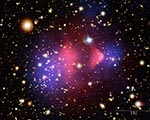Open Innovation Helps the Hunt for the Universe's Missing Material
Published Jan-26-13Breakthrough:
A glaciologist and a signature verification specialist provide fresh thinking to one of astronomy’s biggest questions: where are the missing pieces of the Universe?
Company:
NASA, United States
The Story:
 One of open innovation’s towering strengths is that it encourages people who normally focus on problems in specific fields to apply their techniques to solving challenges in completely different disciplines.
One of open innovation’s towering strengths is that it encourages people who normally focus on problems in specific fields to apply their techniques to solving challenges in completely different disciplines. A wonderful illustration of this occurred during Kaggle’s competition to help find mysterious invisible matter, dubbed ‘dark matter’ that is believed by mainstream astronomy to make up most of the Universe. The contest was organised in conjunction with NASA, the European Space Agency, and the Royal Astronomical Society to generate fresh thinking on this longstanding problem.
Where is our Universe?
The issue is that a chunk of the Universe is missing. In the 1970s an astronomer called Vera Rubin discovered that stars at the edge of galaxies were moving faster than scientists had predicted. To ensure that her findings could fit in with the law of gravity she proposed that there is a kind of matter that we cannot see. Her work was viewed as evidence of research carried out in the 1930s that first postulated the presence dark matter. It is hypothesized to account for a large part of the total mass of the Universe.
Currently, scientists all over the world are engaged in a hunt for what this mysterious material could be. It has only been observed indirectly, by the effect of its gravity on stars.
If dark matter really does exist it means we have a new kind of matter; if it doesn’t, then important scientific theories are wrong.
Competition
Kaggle, a data-mining site created a data competition inviting participants to measure precisely the ellipticity of galaxies from astronomical images. The idea is that if you can measure this accurately you can detect a gravitational effect which is caused by the presence of dark matter.
A total of 73 teams took part and they hailed from a number of different disciplines.
Promising Results
Within ten days of the competition’s launch the leader board was headed up by Martin O’Leary, a PhD student in glaciology. He had created an algorithm that outperformed the cutting edge algorithms most commonly used in astronomy for mapping dark matter. O’Leary used techniques deployed in his field such as detecting edges in glacier fronts from satellite images. But he didn’t stay at the top for long. Within a few days a student in computer vision took the top spot and then a day later a signature verification specialist from Qatar University emerged as the leader.
This ‘leapfrogging’ as it is called was a hallmark of the competition. After someone makes a breakthrough, other participants are driven to improve upon that advance. Eventually the contest was won by two cosmologists, David Kirkby and Daniel Margala.
In addition to providing the field with new ways of searching for dark matter the winners were rewarded with an expenses paid trip to the Jet Propulsion Laboratory (JPL) in Pasadena, California to attend the GREAT10 challenge workshop "Image Analysis for Cosmology".
Shedding Light on Dark Matter
According to the Royal Astronomical Society’s Tom Kitching the benefits of this open innovation contest are clear:
“We are bringing together a collection of experts from fields as diverse as handwriting recognition to string theorists. In the few months since these competitions were launched, we have seen new methods tried, new research directions opened, and a factor 3 increase in the accuracy with which the gravitational lensing signal can be measured.”
Next Story »

